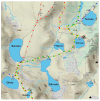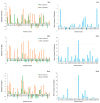Bacterial Metabolic Activity of High-Mountain Lakes in a Context of Increasing Regional Temperature
- PMID: 40572263
- PMCID: PMC12196075
- DOI: 10.3390/microorganisms13061375
Bacterial Metabolic Activity of High-Mountain Lakes in a Context of Increasing Regional Temperature
Abstract
Global warming poses a significant threat to lake ecosystems, with high-mountain lakes being among the earliest and most severely impacted. However, the processes affecting water ecology under climate change remain poorly understood. This study investigates, for the first time, the effects of regional warming on three high-mountain lakes, Sulzata, Okoto and Bubreka, located in the Rila Mountains, Bulgaria, by examining shifts in bacterial metabolic capacity in relation to the rate and range of utilizable carbon sources using the Biolog EcoPlate™ assay. Over the last decade, ice-free water temperatures in the lakes have risen by an average of 2.6 °C, leading to increased nutrient concentrations and enhanced primary productivity, particularly in the shallowest lake. Bacterial communities responded to these changes by increasing their metabolic rates and shifting substrate preferences from carbohydrates to carboxylic acids. While the utilization rates of some carbon sources remained stable, others showed significant changes-some increased (e.g., D-galactonic acid γ-lactone and itaconic acid), while others decreased (e.g., α-D-lactose and D-xylose). The most pronounced effects of warming were observed in June, coinciding with the onset of the growing season. These findings suggest that rising temperatures may substantially alter bacterial metabolic potential, contributing to a long-term positive feedback loop between lake nutrient cycling and climate change.
Keywords: Biolog EcoPlateTM; bacterial functional diversity; bacterial metabolic shifts; glacial lakes; global warming.
Conflict of interest statement
The authors declare no conflicts of interest. The funders supported this scientific work only financially. The funders had no role in the design of the study; in the collection, analyses, or interpretation of data; in the writing of the manuscript; or in the decision to publish the results.
Figures






Similar articles
-
Active body surface warming systems for preventing complications caused by inadvertent perioperative hypothermia in adults.Cochrane Database Syst Rev. 2016 Apr 21;4(4):CD009016. doi: 10.1002/14651858.CD009016.pub2. Cochrane Database Syst Rev. 2016. PMID: 27098439 Free PMC article.
-
Systemic pharmacological treatments for chronic plaque psoriasis: a network meta-analysis.Cochrane Database Syst Rev. 2021 Apr 19;4(4):CD011535. doi: 10.1002/14651858.CD011535.pub4. Cochrane Database Syst Rev. 2021. Update in: Cochrane Database Syst Rev. 2022 May 23;5:CD011535. doi: 10.1002/14651858.CD011535.pub5. PMID: 33871055 Free PMC article. Updated.
-
Systemic pharmacological treatments for chronic plaque psoriasis: a network meta-analysis.Cochrane Database Syst Rev. 2017 Dec 22;12(12):CD011535. doi: 10.1002/14651858.CD011535.pub2. Cochrane Database Syst Rev. 2017. Update in: Cochrane Database Syst Rev. 2020 Jan 9;1:CD011535. doi: 10.1002/14651858.CD011535.pub3. PMID: 29271481 Free PMC article. Updated.
-
Interventions to reduce harm from continued tobacco use.Cochrane Database Syst Rev. 2016 Oct 13;10(10):CD005231. doi: 10.1002/14651858.CD005231.pub3. Cochrane Database Syst Rev. 2016. PMID: 27734465 Free PMC article.
-
Effectiveness and safety of vitamin D in relation to bone health.Evid Rep Technol Assess (Full Rep). 2007 Aug;(158):1-235. Evid Rep Technol Assess (Full Rep). 2007. PMID: 18088161 Free PMC article.
References
-
- Moser K.A., Baron J.S., Brahney J., Oleksy I.A., Saros J.E., Hundey E.J., Sadro S., Kopáček J., Sommaruga R., Kainz M.J., et al. Mountain Lakes: Eyes on Global Environmental Change. Glob. Planet. Chang. 2019;178:77–95. doi: 10.1016/j.gloplacha.2019.04.001. - DOI
-
- Pastorino P., Prearo M. High-Mountain Lakes, Indicators of Global Change: Ecological Characterization and Environmental Pressures. Diversity. 2020;12:260. doi: 10.3390/d12060260. - DOI
-
- Pepin N.C., Arnone E., Gobiet A., Haslinger K., Kotlarski S., Notarnicola C., Palazzi E., Seibert P., Serafin S., Schöner W., et al. Climate Changes and Their Elevational Patterns in the Mountains of the World. Rev. Geophys. 2022;60:e2020RG000730. doi: 10.1029/2020RG000730. - DOI
-
- Rangwala I., Miller J.R. Climate Change in Mountains: A Review of Elevation-Dependent Warming and Its Possible Causes. Clim. Chang. 2012;114:527–547. doi: 10.1007/s10584-012-0419-3. - DOI
-
- Schreder S., Sommaruga R., Psenner R., Chimani B., Ganekind M., Koinig K.A. Changes in Air Temperature, but Not in Precipitation, Determine Long-Term Trends in Water Chemistry of High Mountain Lakes of the Alps with and Without Rock Glacier Influence. Sci. Total Environ. 2023;905:167750. doi: 10.1016/j.scitotenv.2023.167750. - DOI - PubMed
Grants and funding
LinkOut - more resources
Full Text Sources

